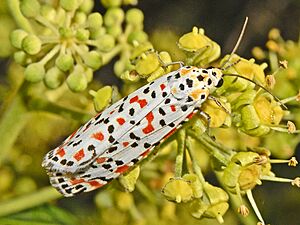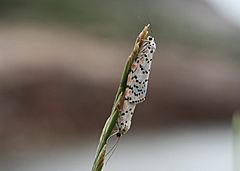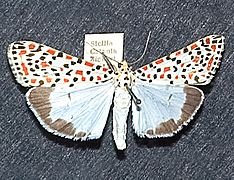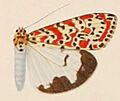Crimson-speckled flunkey facts for kids
Quick facts for kids Crimson-speckled flunkey |
|
|---|---|
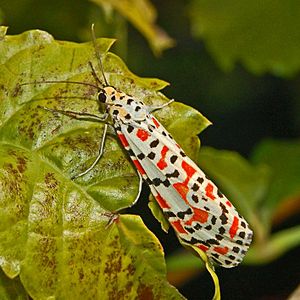 |
|
| Scientific classification | |
| Synonyms | |
|
List
Tinea pulchella Linnaeus, 1758
Deiopeia pulchra Utetheisa callima dilutior Rothschild, 1910 Utetheisa kallima C. Swinhoe, 1907 Utetheisa pulchella completa Weymer, 1908 Lithosia amabilis Trost, 1801 Deiopeia pulchella var. candida Butler, 1877 Noctua pulchra Denis & Schiffermüller, 1775 Utetheisa thytea Rothschild, 1914 Deiopeia thyter Butler, 1877 Utetheisa shyama Bhattacherjee & Gupta, 1969 Utetheisa shiba Bhattacherjee & Gupta, 1969 Utetheisa menoni Bhattacherjee & Gupta, 1969 |
The Utetheisa pulchella, often called the crimson-speckled flunkey, crimson-speckled footman, or crimson-speckled moth, is a type of moth. It belongs to the Erebidae family. A famous scientist named Carl Linnaeus first described this moth in 1758. He wrote about it in his book, the 10th edition of Systema Naturae.
Contents
Different Types of Crimson-Speckled Moths
Within the main species, there are slightly different groups. These are called subspecies. They are like close relatives with small differences.
- Utetheisa pulchella antennata is found in the Nicobar Islands.
- Utetheisa pulchella completa is another type.
- Utetheisa pulchella dilutior lives in places like Angola and Congo.
- Utetheisa pulchella kallima is also found in Angola.
- Utetheisa pulchella pulchella is the original type described by Linnaeus.
Where These Moths Live
This moth is very common and can be found in many parts of the world. It often travels long distances. You might see it in most of Europe, especially as a visitor. It also lives in Africa, North Africa, the Middle East, and Central Asia. In some parts of Asia, it is also found.
In the United Kingdom, it is not always there. It visits only sometimes. These moths like dry, open areas. They live in meadows, shrublands, grasslands, and parks.
What the Crimson-Speckled Moth Looks Like
The Utetheisa pulchella moth has a wingspan of about 29 to 42 millimeters. That's about the length of two small paper clips. Its front wings are narrow. They are white or cream-colored. They have many small black spots. There are also brighter red spots that are a bit bigger. Sometimes, these red spots join together to form stripes.
The back wings are wide and white. They have a black border that is not perfectly even. There are also two black marks in the middle of these wings. The moth's head and body are usually cream or buff yellow. They have patterns similar to the wings. The antennae are long and thin. The lower part of its body, called the abdomen, is smooth and white.
Caterpillar Appearance
The caterpillars of this moth look different from the adults. They are bumpy and dark brown or grayish. They have tufts of grayish hairs. Each body part has an orange line across it. There is a wide whitish line along their back. They also have two other white lines on their sides.
Life of the Crimson-Speckled Moth
In southern Europe, these moths spend the winter as caterpillars. When it's time to change, the caterpillar forms a pupa. This happens on the ground near the plants they eat. They often hide among fallen leaves, dead plants, or pieces of wood. If the winter is mild, especially in warm areas, they might stay as pupae during winter.
Adult moths are usually seen from March to early November. They can have three generations in a year. In warmer, tropical places, they grow all year long. These moths fly both during the day and at night. They are also attracted to lights.
What They Eat
The caterpillars eat many different kinds of plants. They especially like forget-me-not plants, Echium, Borago officinalis, Solanum, Plantago lanceolata, and Anchusa species. In Africa, they mostly eat Trichodesma zeylanicum, Lithospermum, Heliotropium, Trichodesma, and Gossypium plants.
Why They Are Toxic
Because of the plants they eat, the caterpillars take in a lot of special chemicals called alkaloids. These chemicals make the caterpillars and the adult moths toxic. This means they taste bad to birds and other animals that might try to eat them. The bright colors on their wings are a warning sign to predators. This warning is called aposematism. It tells predators, "Don't eat me, I taste bad!"
Gallery
Images for kids
See also
 In Spanish: Nomeolvides (mariposa) para niños
In Spanish: Nomeolvides (mariposa) para niños


